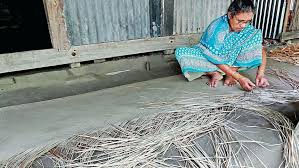
Menu

Barishal, in southern Bangladesh, is renowned for its lush green fields, winding rivers, and rich heritage of handicrafts. Among its most celebrated traditional crafts is Shital Pati weaving, a unique art form that transforms simple murta reeds into beautiful, cool mats prized throughout the region.
“Shital Pati” literally means “cool mat” in Bengali—a name earned from its remarkable ability to provide a soothing surface even in Barishal’s humid summer heat. These mats are traditionally woven from the murta plant (Schumannianthus dichotomus), which grows abundantly along riverbanks and wetlands. The plant’s pliable yet sturdy stalks make it ideal for fine, durable weaving.
The weaving process begins with harvesting the murta reeds, which are then carefully split into thin, even strips. Skilled artisans soak, soften, and smooth these strips to ensure uniformity. In some cases, the strips are dyed using natural or synthetic colors to create striking patterns. The actual weaving is performed on simple handlooms or even on the floor, where artisans interlace the strips into intricate geometric or floral designs.
Beyond their practical use as floor coverings, bedding, or gifts, Shital Patis hold cultural significance. They are essential items in rural homes and are often given as dowry gifts in weddings. Their cool texture makes them an affordable, eco-friendly alternative to synthetic mats, aligning with traditional values of sustainability and harmony with nature.
Weaving Shital Pati is more than a craft—it is a heritage passed down through generations. Entire families or communities often participate in the process, with elders teaching the techniques to the young. In Barishal and nearby districts like Sylhet and Noakhali, clusters of villages specialize in this art, creating vibrant hubs of artisanal production. This tradition also provides an important source of income, especially for women who can weave mats while managing household responsibilities.
Despite its cultural and economic importance, Shital Pati weaving faces challenges from cheap, mass-produced alternatives. However, renewed interest in sustainable and handmade products is offering hope. Government and NGO initiatives are working to improve artisans’ market access, develop new designs, and preserve the knowledge for future generations.
Shital Pati weaving stands as a symbol of Barishal’s artistry, resourcefulness, and deep connection to nature. It embodies the region’s ability to transform humble natural materials into objects of beauty, comfort, and cultural pride—an art that deserves to be celebrated, preserved, and shared with the wider world.



